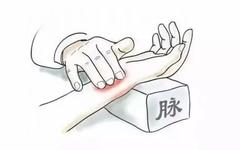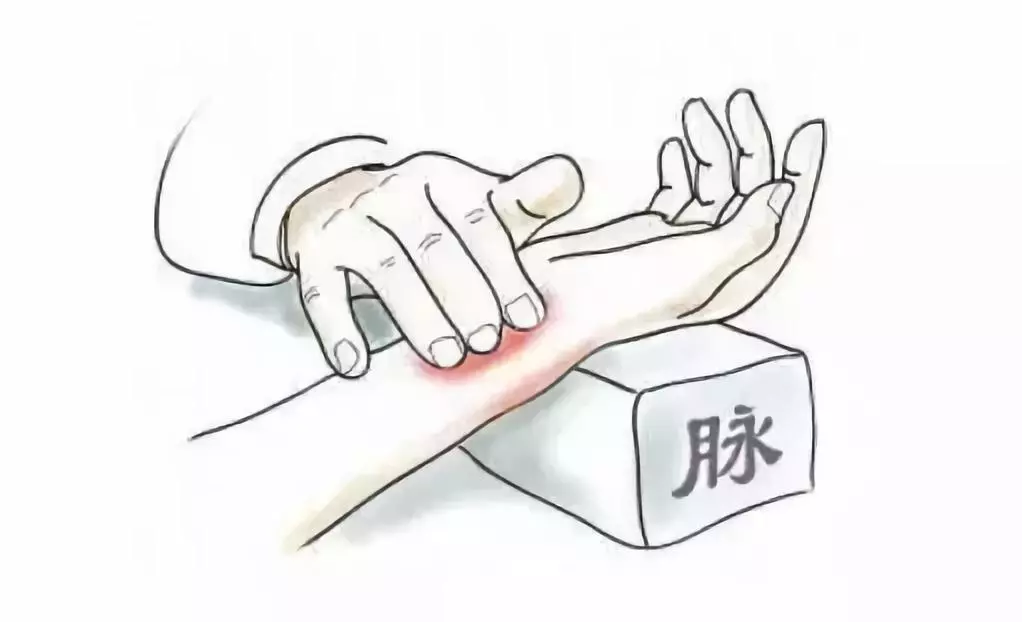
The method of pulse diagnosis in Traditional Chinese Medicine (TCM) refers to the technique where the physician uses their fingers to palpate the patient’s arterial pulse to investigate pulse patterns, thereby understanding the patient’s condition.The pulse examination sites can be divided into three methods: comprehensive examination, three-position examination, and cun-kou examination. Among these, the cun-kou method is the most commonly used. The cun-kou is located at the radial artery pulse point behind both wrists, divided into three sections: cun, guan, and chi. The guan is at the high bone of the palm, the cun is in front of the guan, and the chi is behind the guan. The cun-kou pulse can reflect the qi of the organs: the left cun reflects the heart and small intestine; the left guan reflects the liver and gallbladder; the left chi reflects the kidney and bladder; the right cun reflects the lung; the right guan reflects the spleen and stomach; the right chi reflects the kidney.When performing pulse diagnosis, attention should be paid to the time, posture, and technique. The examination should be conducted in the morning when the patient is inactive. If the patient has been active, they should rest for about 15 minutes before the pulse diagnosis. The patient can be seated or lying down, with the arms extended and palms facing up, bringing the arms close to the same level as the heart. During the examination, three fingers should palpate the pulse simultaneously, applying balanced pressure, starting from light to heavy, categorized into three levels: superficial, moderate, and deep. The pulse diagnosis should last no less than one minute.A healthy person’s pulse should beat four times with each breath, with pulses present in the cun, guan, and chi sections. The pulse should not be floating or sinking, but rather gentle and strong, with the chi pulse being strong when taken deeply. Common pulse types include floating pulse, sinking pulse, slow pulse, rapid pulse, weak pulse, strong pulse, slippery pulse, surging pulse, fine pulse, and wiry pulse.1. Floating Pulse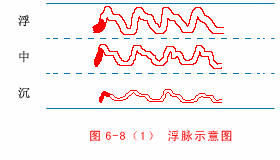 【Body Image Song】Floating on the skin, like wood floating on water; it is abundant when lifted, but insufficient when pressed.【Main Disease Song】Floating pulse is yang, indicating a condition on the surface. Floating pulse at the cun indicates wind; left guan floating indicates wind in the middle jiao; right guan floating indicates phlegm wind in the diaphragm; chi pulse indicates wind in the lower jiao, with difficulty in urination and constipation.【Accompanying Pulse Song】Weak indicates surface deficiency, strong indicates surface excess. Floating tight indicates wind-cold, floating slow indicates wind-stroke; floating rapid indicates wind-heat, floating slow indicates wind-damp. Floating empty indicates blood loss, floating short indicates breathlessness; floating surging indicates empty heat, floating weak indicates heat exhaustion; floating rough indicates blood injury, floating moist indicates qi failure.2. Sinking Pulse
【Body Image Song】Floating on the skin, like wood floating on water; it is abundant when lifted, but insufficient when pressed.【Main Disease Song】Floating pulse is yang, indicating a condition on the surface. Floating pulse at the cun indicates wind; left guan floating indicates wind in the middle jiao; right guan floating indicates phlegm wind in the diaphragm; chi pulse indicates wind in the lower jiao, with difficulty in urination and constipation.【Accompanying Pulse Song】Weak indicates surface deficiency, strong indicates surface excess. Floating tight indicates wind-cold, floating slow indicates wind-stroke; floating rapid indicates wind-heat, floating slow indicates wind-damp. Floating empty indicates blood loss, floating short indicates breathlessness; floating surging indicates empty heat, floating weak indicates heat exhaustion; floating rough indicates blood injury, floating moist indicates qi failure.2. Sinking Pulse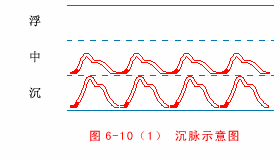 【Body Image Song】Sinking moves like muscles and bones, like a stone thrown into water; it is abundant when pressed, but insufficient when lifted.【Main Disease Song】Sinking pulse is yin, indicating a condition inside. Sinking at the cun indicates shortness of breath and chest pain; it may be phlegm or fluid. Guan indicates internal cold, causing pain and blockage; it may be fullness and discomfort, with acid reflux and muscle tension. Chi indicates back pain, also indicating waist and knee issues; dampness and itching below.【Accompanying Pulse Song】Weak indicates internal deficiency, strong indicates internal excess. Sinking slow indicates cold accumulation, sinking rapid indicates internal heat; sinking slippery indicates phlegm fluid, sinking rough indicates blood stasis; sinking weak indicates deficiency and decline, sinking solid indicates accumulation; sinking tight indicates cold pain, sinking slow indicates damp cold.3. Slow Pulse
【Body Image Song】Sinking moves like muscles and bones, like a stone thrown into water; it is abundant when pressed, but insufficient when lifted.【Main Disease Song】Sinking pulse is yin, indicating a condition inside. Sinking at the cun indicates shortness of breath and chest pain; it may be phlegm or fluid. Guan indicates internal cold, causing pain and blockage; it may be fullness and discomfort, with acid reflux and muscle tension. Chi indicates back pain, also indicating waist and knee issues; dampness and itching below.【Accompanying Pulse Song】Weak indicates internal deficiency, strong indicates internal excess. Sinking slow indicates cold accumulation, sinking rapid indicates internal heat; sinking slippery indicates phlegm fluid, sinking rough indicates blood stasis; sinking weak indicates deficiency and decline, sinking solid indicates accumulation; sinking tight indicates cold pain, sinking slow indicates damp cold.3. Slow Pulse
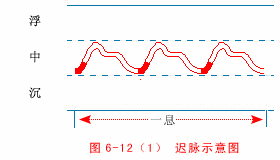
【Body Image Song】Slow pulse belongs to yin, indicating insufficiency; it is slow in rhythm, three beats per breath.【Main Disease Song】Slow pulse indicates organ issues, with cold conditions. Slow at the cun indicates upper cold, causing chest pain; slow at the guan indicates middle cold, with blockages and muscle spasms; slow at the chi indicates fire decline, with difficulty in urination and defecation, or pain in the waist and feet.【Accompanying Pulse Song】Strong indicates cold accumulation, weak indicates cold deficiency. Floating slow indicates surface cold, sinking slow indicates internal cold; slow rough indicates blood deficiency, slow weak indicates damp cold; slow slippery indicates fullness and bloating, slow faint indicates difficulty in settling.4. Rapid Pulse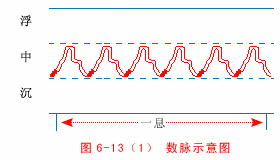 【Body Image Song】Rapid pulse belongs to yang, indicating excess; it beats six times per breath, coming and going frequently.【Main Disease Song】Rapid pulse indicates issues with the bowels, with heat conditions. Rapid at the cun indicates wheezing and coughing, with mouth sores; rapid at the guan indicates stomach heat, with evil fire attacking; rapid at the chi indicates relative fire, with difficulty in urination and dribbling.【Accompanying Pulse Song】Strong indicates real fire, weak indicates false fire. Floating rapid indicates surface heat, sinking rapid indicates internal heat. Yang rapid indicates fire excess, yin rapid indicates relative fire. Right rapid indicates excessive fire, left rapid indicates yin damage.5. Slippery Pulse
【Body Image Song】Rapid pulse belongs to yang, indicating excess; it beats six times per breath, coming and going frequently.【Main Disease Song】Rapid pulse indicates issues with the bowels, with heat conditions. Rapid at the cun indicates wheezing and coughing, with mouth sores; rapid at the guan indicates stomach heat, with evil fire attacking; rapid at the chi indicates relative fire, with difficulty in urination and dribbling.【Accompanying Pulse Song】Strong indicates real fire, weak indicates false fire. Floating rapid indicates surface heat, sinking rapid indicates internal heat. Yang rapid indicates fire excess, yin rapid indicates relative fire. Right rapid indicates excessive fire, left rapid indicates yin damage.5. Slippery Pulse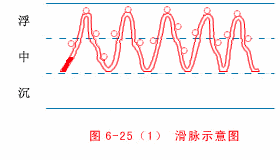 【Body Image Song】Slippery pulse flows smoothly, like beads rolling; it has the shape of a pearl, indicating the essence of dew.【Main Disease Song】Slippery pulse is yang, often indicating phlegm and fluid. Slippery at the cun indicates coughing, fullness in the chest, and nausea; slippery at the guan indicates stomach heat, with obstructed qi and food injury; slippery at the chi indicates urinary issues, or may indicate dysentery, with blood in urine for men and menstrual issues for women.【Accompanying Pulse Song】Floating slippery indicates wind phlegm, sinking slippery indicates phlegm food. Slippery rapid indicates phlegm fire, slippery short indicates breath obstruction. Slippery and floating indicates pain in the lower abdomen. Slippery and floating indicates stroke paralysis. Slippery and harmonious indicates pregnancy can be determined.6. Rough Pulse
【Body Image Song】Slippery pulse flows smoothly, like beads rolling; it has the shape of a pearl, indicating the essence of dew.【Main Disease Song】Slippery pulse is yang, often indicating phlegm and fluid. Slippery at the cun indicates coughing, fullness in the chest, and nausea; slippery at the guan indicates stomach heat, with obstructed qi and food injury; slippery at the chi indicates urinary issues, or may indicate dysentery, with blood in urine for men and menstrual issues for women.【Accompanying Pulse Song】Floating slippery indicates wind phlegm, sinking slippery indicates phlegm food. Slippery rapid indicates phlegm fire, slippery short indicates breath obstruction. Slippery and floating indicates pain in the lower abdomen. Slippery and floating indicates stroke paralysis. Slippery and harmonious indicates pregnancy can be determined.6. Rough Pulse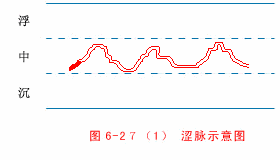 【Body Image Song】Rough pulse is stagnant, like a knife scraping bamboo; it is slow, fine, and short, with three images of fear.【Main Disease Song】Rough indicates blood deficiency, also indicating essence injury. Rough at the cun indicates heart pain, or palpitations. Rough at the guan indicates yin deficiency, causing internal heat; right guan indicates earth deficiency, left guan indicates fullness. Rough at the chi indicates urinary issues, with blood in urine; pregnancy indicates fetal issues, with blood loss.【Accompanying Pulse Song】Rough and strong indicates real heat; rough and weak indicates false heat.7. Weak Pulse
【Body Image Song】Rough pulse is stagnant, like a knife scraping bamboo; it is slow, fine, and short, with three images of fear.【Main Disease Song】Rough indicates blood deficiency, also indicating essence injury. Rough at the cun indicates heart pain, or palpitations. Rough at the guan indicates yin deficiency, causing internal heat; right guan indicates earth deficiency, left guan indicates fullness. Rough at the chi indicates urinary issues, with blood in urine; pregnancy indicates fetal issues, with blood loss.【Accompanying Pulse Song】Rough and strong indicates real heat; rough and weak indicates false heat.7. Weak Pulse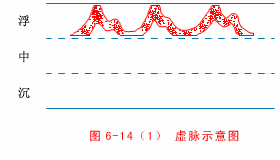 【Body Image Song】Weak pulse is small and soft, barely felt; it is almost invisible when lifted, but can be felt when pressed.【Main Disease Song】Weak indicates yang deficiency, with true qi weakness. Weak at the left cun indicates heart deficiency, causing palpitations; weak at the right cun indicates lung deficiency, with spontaneous sweating and breathlessness. Weak at the left guan indicates liver injury, with blood not nourishing the muscles; weak at the right guan indicates spleen cold, with food not digesting. Weak at the left chi indicates water decline, with weakness in the waist and knees; weak at the right chi indicates fire decline, with cold symptoms.8. Strong Pulse
【Body Image Song】Weak pulse is small and soft, barely felt; it is almost invisible when lifted, but can be felt when pressed.【Main Disease Song】Weak indicates yang deficiency, with true qi weakness. Weak at the left cun indicates heart deficiency, causing palpitations; weak at the right cun indicates lung deficiency, with spontaneous sweating and breathlessness. Weak at the left guan indicates liver injury, with blood not nourishing the muscles; weak at the right guan indicates spleen cold, with food not digesting. Weak at the left chi indicates water decline, with weakness in the waist and knees; weak at the right chi indicates fire decline, with cold symptoms.8. Strong Pulse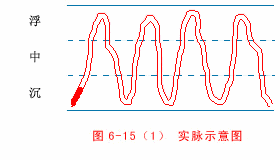 【Body Image Song】Strong pulse is powerful, long, and firm; it responds strongly to pressure, with all three positions being the same.【Main Disease Song】Strong pulse indicates blood excess, with heat and obstruction. Strong at the left cun indicates heart strain, with strong tongue and qi surging; strong at the right cun indicates lung disease, with nausea and throat pain. Strong at the left guan indicates liver fire pain; strong at the right guan indicates fullness and pain. Strong at the left chi indicates constipation and abdominal pain; strong at the right chi indicates relative fire and reversal.【Accompanying Pulse Song】Strong and tight indicates cold accumulation. Strong and slippery indicates phlegm accumulation.9. Long Pulse
【Body Image Song】Strong pulse is powerful, long, and firm; it responds strongly to pressure, with all three positions being the same.【Main Disease Song】Strong pulse indicates blood excess, with heat and obstruction. Strong at the left cun indicates heart strain, with strong tongue and qi surging; strong at the right cun indicates lung disease, with nausea and throat pain. Strong at the left guan indicates liver fire pain; strong at the right guan indicates fullness and pain. Strong at the left chi indicates constipation and abdominal pain; strong at the right chi indicates relative fire and reversal.【Accompanying Pulse Song】Strong and tight indicates cold accumulation. Strong and slippery indicates phlegm accumulation.9. Long Pulse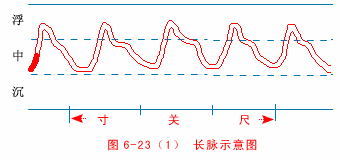 【Body Image Song】Long pulse is long and continuous, with both ends being distinct; it moves straight up and down, like following a long pole.【Main Disease Song】Long indicates excess, with qi reversal and fire excess. Long at the left cun indicates fire disease; long at the right cun indicates fullness and reversal. Long at the left guan indicates wood excess; long at the right guan indicates earth fullness and bloating. Long at the left chi indicates rebellious qi; long at the right chi indicates relative fire.10. Short Pulse
【Body Image Song】Long pulse is long and continuous, with both ends being distinct; it moves straight up and down, like following a long pole.【Main Disease Song】Long indicates excess, with qi reversal and fire excess. Long at the left cun indicates fire disease; long at the right cun indicates fullness and reversal. Long at the left guan indicates wood excess; long at the right guan indicates earth fullness and bloating. Long at the left chi indicates rebellious qi; long at the right chi indicates relative fire.10. Short Pulse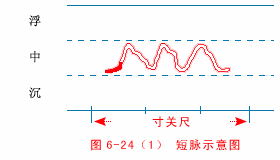 【Body Image Song】Short pulse is small and tight, with both ends being low; it is raised in the middle, unable to fill the entire area.【Main Disease Song】Short indicates insufficiency, indicating qi deficiency. Short at the cun indicates heart instability; short at the right cun indicates lung deficiency and headache. Short at the left guan indicates liver qi injury; short at the right guan indicates issues in the diaphragm. Short at the left chi indicates lower abdominal pain; short at the right chi indicates true fire not rising.11. Surging Pulse
【Body Image Song】Short pulse is small and tight, with both ends being low; it is raised in the middle, unable to fill the entire area.【Main Disease Song】Short indicates insufficiency, indicating qi deficiency. Short at the cun indicates heart instability; short at the right cun indicates lung deficiency and headache. Short at the left guan indicates liver qi injury; short at the right guan indicates issues in the diaphragm. Short at the left chi indicates lower abdominal pain; short at the right chi indicates true fire not rising.11. Surging Pulse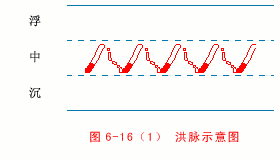 【Body Image Song】Surging pulse is extremely large, resembling a flood; it comes strong and goes weak, flowing abundantly.【Main Disease Song】Surging indicates fullness, with qi obstruction and fire excess. Surging at the left cun indicates heart agitation; surging at the right cun indicates fullness and qi reversal. Surging at the left guan indicates excessive liver wood; surging at the right guan indicates bloating and heat. Surging at the left chi indicates dryness and difficulty in urination; surging at the right chi indicates fire burning.12. Faint Pulse
【Body Image Song】Surging pulse is extremely large, resembling a flood; it comes strong and goes weak, flowing abundantly.【Main Disease Song】Surging indicates fullness, with qi obstruction and fire excess. Surging at the left cun indicates heart agitation; surging at the right cun indicates fullness and qi reversal. Surging at the left guan indicates excessive liver wood; surging at the right guan indicates bloating and heat. Surging at the left chi indicates dryness and difficulty in urination; surging at the right chi indicates fire burning.12. Faint Pulse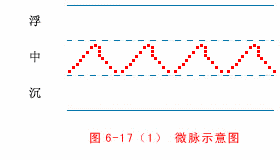 【Body Image Song】Faint pulse is extremely fine and soft; it is almost imperceptible, appearing to be absent.【Main Disease Song】Faint pulse is vague, indicating severe deficiency of qi and blood. Faint at the left cun indicates fright; faint at the right cun indicates breathlessness. Faint at the left guan indicates cold and spasms; faint at the right guan indicates stomach cold. Faint at the left chi indicates severe depletion of essence; faint at the right chi indicates yang decline and imminent death.13. Fine Pulse
【Body Image Song】Faint pulse is extremely fine and soft; it is almost imperceptible, appearing to be absent.【Main Disease Song】Faint pulse is vague, indicating severe deficiency of qi and blood. Faint at the left cun indicates fright; faint at the right cun indicates breathlessness. Faint at the left guan indicates cold and spasms; faint at the right guan indicates stomach cold. Faint at the left chi indicates severe depletion of essence; faint at the right chi indicates yang decline and imminent death.13. Fine Pulse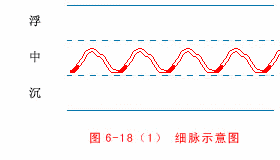 【Body Image Song】Fine pulse is straight and soft, winding and coiling; it resembles a silk thread, more apparent than faint.【Main Disease Song】Fine indicates qi decline, with various deficiencies. Fine at the left cun indicates palpitations and insomnia; fine at the right cun indicates nausea and breathlessness. Fine at the left guan indicates liver yin depletion; fine at the right guan indicates stomach fullness.Fine at the left chi indicates diarrhea and seminal emission; fine at the right chi indicates cold and fatigue.14. Moist Pulse
【Body Image Song】Fine pulse is straight and soft, winding and coiling; it resembles a silk thread, more apparent than faint.【Main Disease Song】Fine indicates qi decline, with various deficiencies. Fine at the left cun indicates palpitations and insomnia; fine at the right cun indicates nausea and breathlessness. Fine at the left guan indicates liver yin depletion; fine at the right guan indicates stomach fullness.Fine at the left chi indicates diarrhea and seminal emission; fine at the right chi indicates cold and fatigue.14. Moist Pulse
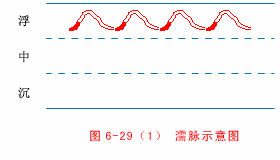
【Body Image Song】Moist pulse is fine and soft, felt at the floating level; it is seen when lifted, but disappears when pressed.【Main Disease Song】Moist indicates yin deficiency, with essence depletion. Moist at the left cun indicates forgetfulness and palpitations; moist at the right cun indicates spontaneous sweating. Moist at the left guan indicates blood not nourishing the muscles; moist at the right guan indicates spleen deficiency with dampness. Moist at the left chi indicates essence and blood depletion; moist at the right chi indicates fire decline and life-threatening.15. Weak Pulse
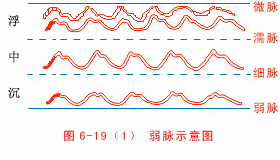
【Body Image Song】Weak pulse is small and soft, felt at the sinking level; it is absent when lifted, but can be felt when pressed.【Main Disease Song】Weak indicates yang collapse, with true qi weakness. Weak at the left cun indicates heart deficiency, causing palpitations and forgetfulness; weak at the right cun indicates lung deficiency, with spontaneous sweating and breathlessness. Weak at the left guan indicates wood depletion, causing pain; weak at the right guan indicates earth cold, with digestive issues. Weak at the left chi indicates depletion, with signs of decline; weak at the right chi indicates yang collapse.16. Tight Pulse
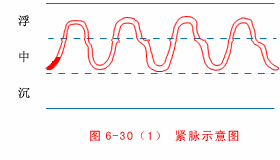
【Body Image Song】Tight pulse is strong, with a snapping quality; it feels like a twisted rope, or a tightly pulled string.【Main Disease Song】Tight indicates cold evil, also indicating various pains. Tight at the left cun indicates fullness and acute pain; tight at the right cun indicates cold damage and wheezing. Tight at the left guan indicates wind-cold; tight at the right guan indicates food stagnation. Tight at the left chi indicates severe pain below the navel; tight at the right chi indicates relative fire and issues.17. Slow Pulse
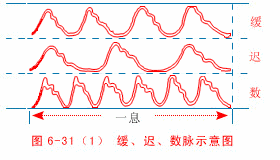
【Body Image Song】Slow pulse has four beats, coming and going evenly; it is like a gentle breeze, reminiscent of early spring willows.【Main Disease Accompanying Pulse Song】Slow indicates stomach qi, not indicating disease; it can only be diagnosed when accompanied by other signs. Floating slow indicates wind damage, sinking slow indicates cold damp. Slow large indicates wind deficiency, slow fine indicates damp obstruction. Slow rough indicates spleen weakness, slow weak indicates qi deficiency. Right cun floating slow indicates wind evil; left cun rough slow indicates blood deficiency.Left guan floating slow indicates liver wind; right guan sinking slow indicates weakness from damp invasion. Left chi floating slow indicates insufficient essence; right chi fine slow indicates extreme decline of true yang.18. Wiry Pulse
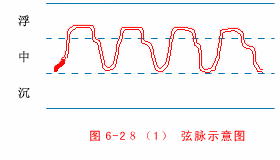
【Body Image Song】Wiry pulse is like a string, light and soft; it is straight and long, with a firm feel under the fingers.【Main Disease Song】Wiry indicates liver wind, indicating pain, malaria, phlegm, and fluid. Wiry at the left cun indicates heart pain; wiry at the right cun indicates chest and head pain. Wiry at the left guan indicates phlegm and malaria; wiry at the right guan indicates stomach cold pain. Wiry at the left chi indicates fluid in the lower jiao; wiry at the right chi indicates leg cramps and pain.【Accompanying Pulse Song】Floating wiry indicates fluid retention, sinking wiry indicates suspended fluid. Wiry rapid indicates heat, wiry slow indicates cold. Wiry large indicates deficiency, wiry fine indicates tightness. Yang wiry indicates headache, yin wiry indicates abdominal pain. Single wiry indicates fluid issues, double wiry indicates cold accumulation.19. Moving Pulse
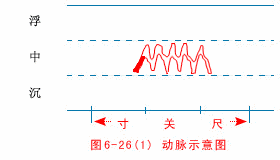
【Body Image Song】Moving pulse has no head or tail, moving like a bean; it shakes and trembles, often accompanied by slippery and rapid.【Main Disease Song】Moving pulse indicates pain, also indicating fright. Moving at the left cun indicates palpitations; moving at the right cun indicates spontaneous sweating. Moving at the left guan indicates fright and spasms; moving at the right guan indicates heart and spleen pain. Moving at the left chi indicates loss of essence; moving at the right chi indicates rapid fire.20. Rapid Pulse
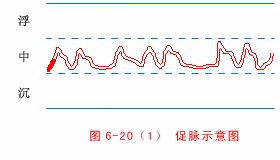
【Body Image Song】Rapid pulse is quick and abrupt, stopping intermittently; it is like rushing and stumbling, advancing leads to death.【Main Disease Song】Rapid indicates fire excess, also due to stagnation. Rapid at the left cun indicates heart fire; rapid at the right cun indicates lung wheezing. Rapid at the left guan indicates blood stagnation; rapid at the right guan indicates food stagnation. Rapid at the left chi indicates slippery issues; rapid at the right chi indicates burning heat.21. Knotted Pulse
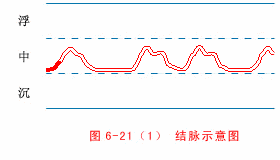
【Body Image Song】Knotted indicates stagnation, stopping intermittently; it moves slowly and lazily, often achieving its purpose.【Main Disease Song】Knotted indicates yin cold, also due to accumulation. Knotted at the left cun indicates heart cold, with pain; knotted at the right cun indicates lung deficiency, with qi cold accumulation; knotted at the left guan indicates hernia; knotted at the right guan indicates phlegm stagnation and food retention. Knotted at the left chi indicates weakness; knotted at the right chi indicates yin cold symptoms.22. Absent Pulse
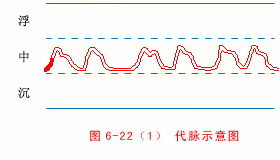
【Body Image Song】Absent pulse indicates a lack of regularity; it cannot return to its original state, taking a long time to move again.【Main Disease Song】Absent indicates organ decline, a sign of danger. Spleen deficiency leads to vomiting and diarrhea; middle cold leads to difficulty in eating, with abdominal pain. Two movements and one stop indicate death in three to four days; four movements and one stop indicate death in six to seven days. Sequentially deducing does not lose the essence of the classics.23. Leather Pulse
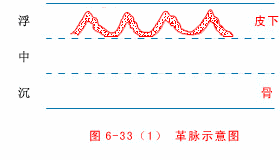
【Body Image Song】Leather pulse is large and tense, easily felt at the floating level; it feels empty when pressed, like a drum skin.【Main Disease Song】Leather indicates surface cold, also indicating internal deficiency. Leather at the left cun indicates heart blood deficiency; leather at the right cun indicates metal decline and qi obstruction. Leather at the left guan indicates hernia; leather at the right guan indicates earth deficiency and pain. Leather at the left chi indicates essence depletion; leather at the right chi indicates imminent death. Women with this pulse may experience postpartum hemorrhage.24. Firm Pulse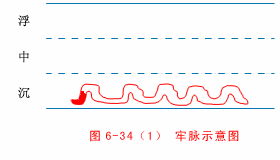 【Body Image Song】Firm pulse is felt at the sinking level, large and firm; it is difficult to feel at the floating level, almost impossible to detect.【Main Disease Song】Firm indicates accumulation. The disease is internal. Firm at the left cun indicates hidden illness; firm at the right cun indicates stable conditions. Firm at the left guan indicates blood accumulation in the liver; firm at the right guan indicates cold and fullness. Firm at the left chi indicates rebellious qi; firm at the right chi indicates severe pain.25. Scattered Pulse
【Body Image Song】Firm pulse is felt at the sinking level, large and firm; it is difficult to feel at the floating level, almost impossible to detect.【Main Disease Song】Firm indicates accumulation. The disease is internal. Firm at the left cun indicates hidden illness; firm at the right cun indicates stable conditions. Firm at the left guan indicates blood accumulation in the liver; firm at the right guan indicates cold and fullness. Firm at the left chi indicates rebellious qi; firm at the right chi indicates severe pain.25. Scattered Pulse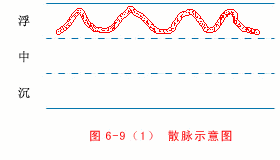 【Body Image Song】Scattered pulse is chaotic, with surface but no interior; it gradually empties in the middle, disappearing when pressed.【Main Disease Song】Scattered indicates primary injury, indicating danger. Scattered at the left cun indicates palpitations and insomnia; scattered at the right cun indicates excessive sweating. Scattered at the left guan indicates fluid overflow; scattered at the right guan indicates fullness and illness. Located at the left chi indicates water depletion; scattered at the right chi indicates yang collapse and imminent death.26. Hollow Pulse
【Body Image Song】Scattered pulse is chaotic, with surface but no interior; it gradually empties in the middle, disappearing when pressed.【Main Disease Song】Scattered indicates primary injury, indicating danger. Scattered at the left cun indicates palpitations and insomnia; scattered at the right cun indicates excessive sweating. Scattered at the left guan indicates fluid overflow; scattered at the right guan indicates fullness and illness. Located at the left chi indicates water depletion; scattered at the right chi indicates yang collapse and imminent death.26. Hollow Pulse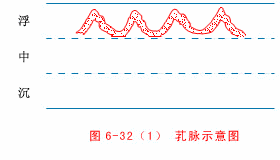 【Body Image Song】Hollow pulse is empty, indicating a lack of essence; it is felt at the floating level, with both floating and sinking.【Main Disease Song】Hollow pulse indicates internal emptiness, leading to blood loss. Hollow at the left cun indicates heart blood loss; hollow at the right cun indicates relative injury. Hollow at the left guan indicates liver blood not stored; hollow at the right guan indicates spleen blood not absorbed. Hollow at the left chi indicates red urine; hollow at the right chi indicates fire burning and essence leaking.27. Hidden Pulse
【Body Image Song】Hollow pulse is empty, indicating a lack of essence; it is felt at the floating level, with both floating and sinking.【Main Disease Song】Hollow pulse indicates internal emptiness, leading to blood loss. Hollow at the left cun indicates heart blood loss; hollow at the right cun indicates relative injury. Hollow at the left guan indicates liver blood not stored; hollow at the right guan indicates spleen blood not absorbed. Hollow at the left chi indicates red urine; hollow at the right chi indicates fire burning and essence leaking.27. Hidden Pulse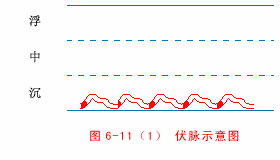 【Body Image Song】Hidden pulse is concealed, deeper than sinking; it feels like pushing against the bones, only then can its shape be felt.【Main Disease Song】Hidden pulse is yin, indicating deep-seated illness. Hidden at the left cun indicates blood stagnation; hidden at the right cun indicates qi stagnation. Hidden at the left guan indicates liver blood in the abdomen; hidden at the right guan indicates cold condensing food. Hidden at the left chi indicates hernia; hidden at the right chi indicates fire decline.28. Rapid Pulse
【Body Image Song】Hidden pulse is concealed, deeper than sinking; it feels like pushing against the bones, only then can its shape be felt.【Main Disease Song】Hidden pulse is yin, indicating deep-seated illness. Hidden at the left cun indicates blood stagnation; hidden at the right cun indicates qi stagnation. Hidden at the left guan indicates liver blood in the abdomen; hidden at the right guan indicates cold condensing food. Hidden at the left chi indicates hernia; hidden at the right chi indicates fire decline.28. Rapid Pulse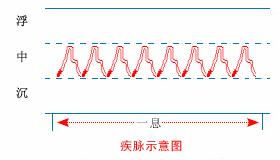 【Body Image Song】Rapid indicates extreme urgency, with the highest frequency; seven to eight beats indicate a thin and rapid pulse.【Main Disease Song】Rapid indicates extreme yang, with yin qi about to deplete; the pulse is irregular, indicating imminent danger; gradually increasing urgency indicates a high risk of death. Rapid at the left cun indicates self-destructive tendencies; rapid at the right cun indicates metal being consumed by fire. Rapid at the left guan indicates liver yin depletion; rapid at the right guan indicates spleen yin depletion. Rapid at the left chi indicates severe depletion; rapid at the right chi indicates imminent death.· The End · Note:This platform shares health-related graphic information for reference and learning purposes only, and should not be used as a basis for medical diagnosis. If needed, please consult a physician for guidance.⊙ Copyright Statement: The article is sourced from the internet; if there is any infringement, please contact us for removal.
【Body Image Song】Rapid indicates extreme urgency, with the highest frequency; seven to eight beats indicate a thin and rapid pulse.【Main Disease Song】Rapid indicates extreme yang, with yin qi about to deplete; the pulse is irregular, indicating imminent danger; gradually increasing urgency indicates a high risk of death. Rapid at the left cun indicates self-destructive tendencies; rapid at the right cun indicates metal being consumed by fire. Rapid at the left guan indicates liver yin depletion; rapid at the right guan indicates spleen yin depletion. Rapid at the left chi indicates severe depletion; rapid at the right chi indicates imminent death.· The End · Note:This platform shares health-related graphic information for reference and learning purposes only, and should not be used as a basis for medical diagnosis. If needed, please consult a physician for guidance.⊙ Copyright Statement: The article is sourced from the internet; if there is any infringement, please contact us for removal.
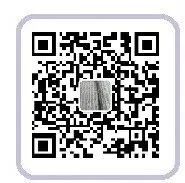
It is most incredible that you have not clicked “Looking”

